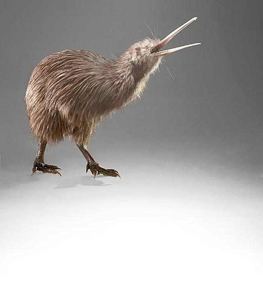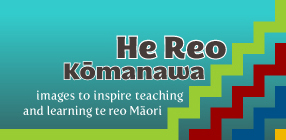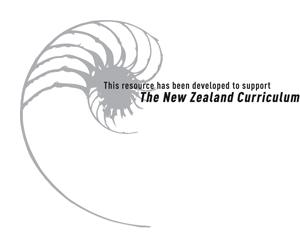
ImageTeaching and learning sequenceAdditional tasks and activities
Sample Task Sequence 1: North Island Brown Kiwi
Digital resource from the Te Papa Collection
Image: North Island Brown Kiwi


Acknowledgements
Copyright: Reproduced courtesy of the Museum of New Zealand Te Papa Tongarewa
Creator:
Identifiers: Museum of New Zealand Te Papa Tongarewa number OR.025020. TLF resource R2455
Source: Museum of New Zealand Te Papa Tongarewa, http://www.tepapa.govt.nz
Students should be able to:
2.2 communicate about possession;
2.5 communicate about physical characteristics, personalities, and feelings.
Links to other learning areas
Science, the arts (visual arts)
Te reo Māori text
He kiwi tēnei manu. Ko tēnei te kiwi parāone, nō te Ika a Māui. He parāone ōna huruhuru me ōna waewae. He whanaunga tata te kiwi me te moa. He whanaunga hoki ki te emu o Ahitereiria. Ko te kiwi te manu iti rawa o ēnei momo manu. Ahakoa he manu iti te kiwi, he tino nui tana hēki.
Statements: Kei te tika/Kāore i te tika
1. He kiwi te manu nei.
2. He mā ngā huruhuru o tēnei kiwi.
3. He whanaunga te kiwi ki te moa.
4. He whanaunga hoki te kiwi ki te tūī.
5. Nō Ahitereiria te kiwi.
6. He kaha te kiwi ki te rere.
Teaching and learning sequence
When appropriate, the teacher shares the intended learning outcomes with the students and negotiates success criteria with them. The teacher and students discuss these throughout the teaching and learning sequence.
1. Viewing of image
The students view the image: North Island Brown Kiwi.
2. Pre-reading discussion
The students work in pairs or groups of four, discussing the image and sharing any information they know about kiwi. If discussion in te reo Māori is beyond them, they could conduct their discussion mainly in English and simply make a word bank of relevant te reo Māori vocabulary. The teacher then leads a class discussion and asks questions such as whether any of the students have seen a kiwi, where they saw it, and why so few people see kiwi in the wild.
The questions and discussion could be in te reo Māori and/or English. The teacher records key new te reo Māori vocabulary to create a class word bank.
3. Reading te reo Māori text
The students read the text silently, but are free to discuss any areas of difficulty in their pairs or small groups. If they are still unsure of some words after they have shared their ideas and tried to work out the new vocabulary, they may consult a dictionary. After the reading, the teacher encourages them to use a dictionary to confirm their guesses.
4. Teacher clarification
The teacher draws attention to new vocabulary and grammar and clarifies any remaining uncertainties.
5. Pair interactive task
In pairs, the students take turns to read the Kei te tika/Kāore i te tika statements. The listener says “Kei te tika” if the sentence is correct or “Kāore i te tika” if it is wrong. If it is wrong, the same student must correct the error. For example, Statement 2 is “He mā ngā huruhuru o te kiwi”. This statement is wrong, so the student says, “Kāore i te tika” and corrects the statement. The correction may be made in any of the following ways:
- by repeating the statement, but with the error corrected (for example, “He parāone ngā huruhuru o te kiwi nei”);
- by using an appropriate sentence from the text (for example, “He parāone ōna huruhuru me ōna waewae”); or
- in the student’s own words (for example, “He parāone ngā huruhuru o tēnei kiwi”). When the students have completed the list of statements, they make up some Kei te tika/Kāore i te tika statements of their own for their partner to respond to. The ideas for these could come from their own knowledge and/or from the text.
6. Group mind mapping
Working in groups of four, the students make a mind map of what they collectively know about the kiwi. This mind map is kept safe, as it will be used later, with additional information, in the presentation.
Download example mind map (.pdf)
7. Inquiry
Facilitated by the teacher, the students discuss what other information they want to find out about the kiwi. Topics for the inquiry might include:
- Unusual features of the kiwi
- Kiwi diet, behaviour, and the roles of males and females • Additional threats to kiwi survival
- Current measures to protect kiwi
- Different kiwi species and where they are found.
Each group forms a written question on which to focus their inquiry and then each student makes an inquiry plan that identifies how they will seek answers to their question. This might be through reading (using the library or Internet), museum visits, or interviewing whānau members or kaumātua who have knowledge of kiwi and their habits and former habitats in the district. The students get approval from the teacher for their questions and inquiry plans. While the teacher provides support and oversight, the students undertake at least part of their inquiries for homework. They make written notes in which they record keywords and simple sentences in te reo Māori, and they bring these notes to school.
8. Addition of information to group mind maps
The class discusses the criteria for an effective mind map. Then, in their groups, the students pool the results of their inquiries and discuss how their findings can be incorporated into their group mind maps. This involves group discussion and the synthesis, prioritisation, and organisation of information. As the students work, the teacher circulates, helping with vocabulary and encouraging the students to kōrero Māori.
9. Presentation
The teacher selects a method of presentation, perhaps choosing from one of the five suggestions in this resource.
10. Reflection
The students are given 5–10 minutes to reflect individually on what they have learned from this cycle of learning. They record their reflections briefly in te reo Māori, listing the new vocabulary they learned and writing one new piece of information or new idea that they gained from their inquiry.
At this early level, teachers could offer the students a template for their reflections.
Additional tasks and activities
Depending on their students’ needs and interests, teachers may like to select from some of the following tasks and activities:
- Research and dramatise traditional or modern stories featuring kiwi, with the dialogue including as much te reo Māori as possible.
- Research other birds in the kiwi whānau – the kiwi’s indigenous and international cousins.
- Create labelled diagrams of kiwi, with all the labels in te reo Māori.
- Describe features common to various members of the kiwi whānau (for example, body shape, reduced wing size, strong legs, similarities in behaviour patterns).
- Research New Zealand birds that are endangered, and explore conservation initiatives.
- Create artwork depicting kiwi (for example, paintings, pencil drawings, collage, crayon and dye). Write captions for the artwork in te reo Māori. He Wakahuia Toi Māori: Māori Visual Culture in Visual Arts Education Years 1–6 (Ministry of Education, 2007) includes a unit called Nga Ahua o Tane that could provide a helpful starting point for this work.
- Visit a museum to view and discuss kiwi exhibits.
- Discuss the kiwi as a major New Zealand icon and find examples of kiwi imagery.
- Create advertising slogans in te reo Māori to promote an imaginary product, and illustrate the slogans with original kiwi graphics.


